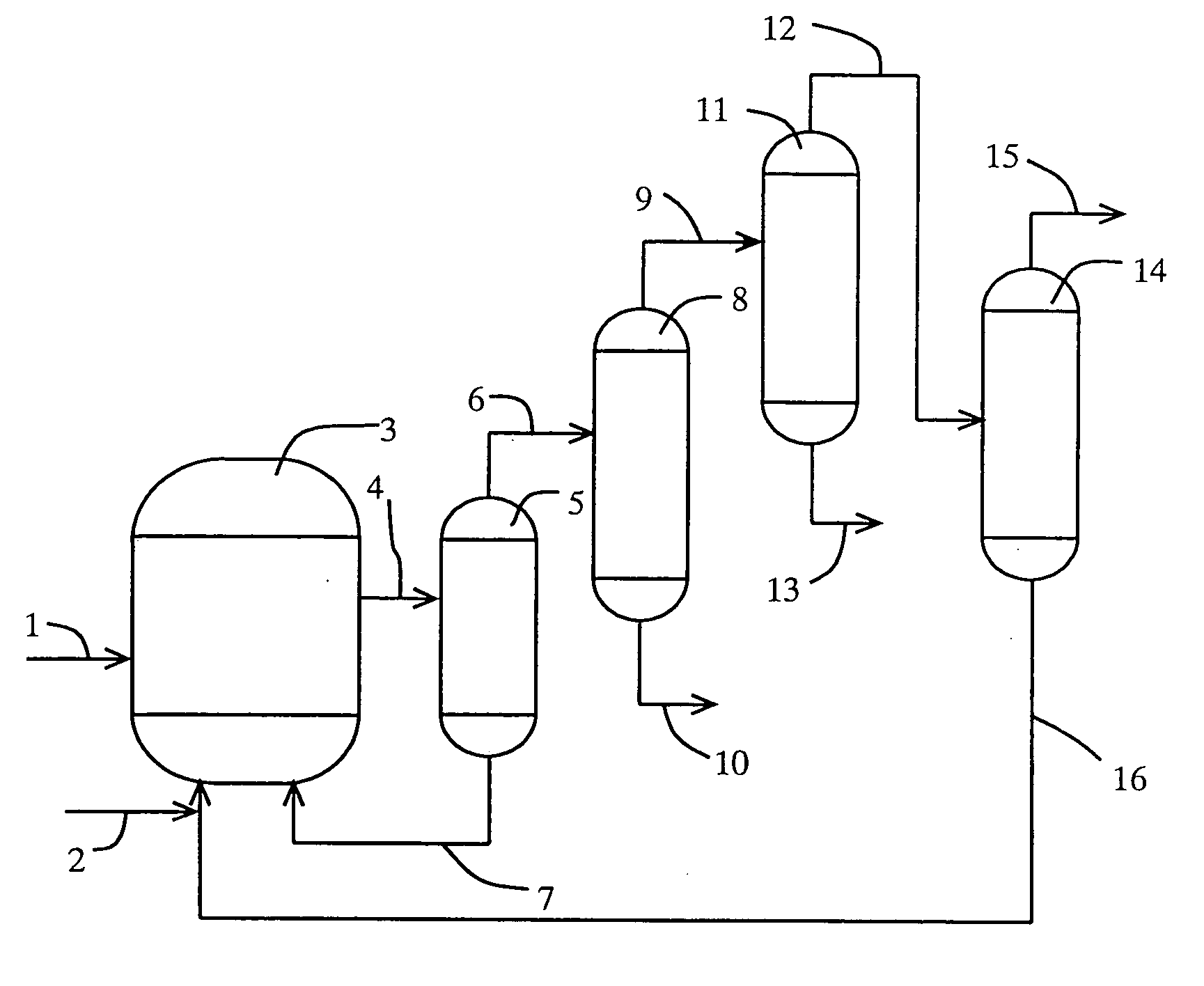Process for producing carboxylic acid and system for producing the same
- Summary
- Abstract
- Description
- Claims
- Application Information
AI Technical Summary
Benefits of technology
Problems solved by technology
Method used
Image
Examples
example 1
[0142] (1) Carbonylation Reaction
[0143] A rhodium catalyst, lithium iodide, methyl iodide, and water were supplied to a reactor at prescribed amounts so that the concentration of the rhodium catalyst, that of lithium iodide, that of methyl iodide, and that of water were 400 ppm, 0.5 mol / L, 14% by weight, and 8% by weight in a mixture (liquid-phase system), respectively. The reaction was carried out at 187° C. with feeding carbon monoxide and methanol to the reactor continuously to form acetic acid.
[0144] (2) Separation Step of Higher Bp Catalyst Component
[0145] The reaction mixture (or crude reaction solution) obtained in the reaction step (1) was distilled with the use of a distillation column (catalyst-separating column) (temperature of 132° C., pressure of 252 kPa), and was separated into a less-volatile phase (bottom fraction) and a higher-volatile phase (overhead fraction). The less-volatile phase containing the rhodium catalyst and the salt of iodide (lithium iodide) as mai...
example 2
[0151] (1) Purification Step
[0152] The overhead fraction (crude mixture) which was obtained in the separation step (2) of the higher bp catalyst component in Example 1 was supplied to the 9th plate from the top of a first distillation column (lower bp component-separation column) (theoretical plate number of 10, operation pressure of 294 kPa as overhead pressure) at a rate of 1,200 g / h. The reflux ratio of the lower bp component-separation column was 1592, and the distillate was distilled off from the overhead of the column at a distillation rate of 0.6 g / h. The resultant overhead fraction contained 20% by weight of acetaldehyde, 3% by weight of water, and methyl iodide as the rest.
[0153] The bottom solution which was withdrawn from the bottom of the lower bp component-separation column was fed to the overhead of a second distillation column (higher bp component-separation column) (theoretical plate number of 14, operation pressure in the distillation column of 101 kPa as overhead...
example 3
[0157] (1) Purification Step
[0158] The overhead fraction (crude mixture) distilled from the overhead in the separation step (2) of the higher bp catalyst component in Example 1 was supplied to the 22nd plate from the top of a first distillation column (lower bp component-separation column) (theoretical plate number of 40, operation pressure of 101 kPa as overhead pressure) at a rate of 1200 g / h. The reflux ratio of the lower bp component-separation column was 1.37, and the bottom solution was withdrawn from the column bottom at a bottom rate of 631.1 g / h. The bottom solution contained 0.9% by weight of water, 0.02% by weight of propionic acid, and acetic acid as the rest.
[0159] The bottom solution which was withdrawn from the column bottom of the lower bp component-separation column was supplied to the second plate from the top of a second distillation column (higher bp component-separation column) (theoretical plate number of 27, operation pressure of 98 kPa as overhead pressure)...
PUM
| Property | Measurement | Unit |
|---|---|---|
| Percent by mass | aaaaa | aaaaa |
| Weight | aaaaa | aaaaa |
| Fraction | aaaaa | aaaaa |
Abstract
Description
Claims
Application Information
 Login to View More
Login to View More - R&D
- Intellectual Property
- Life Sciences
- Materials
- Tech Scout
- Unparalleled Data Quality
- Higher Quality Content
- 60% Fewer Hallucinations
Browse by: Latest US Patents, China's latest patents, Technical Efficacy Thesaurus, Application Domain, Technology Topic, Popular Technical Reports.
© 2025 PatSnap. All rights reserved.Legal|Privacy policy|Modern Slavery Act Transparency Statement|Sitemap|About US| Contact US: help@patsnap.com



